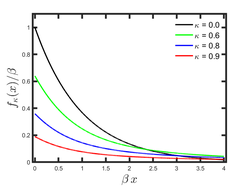Kaniadakis exponential distribution
Probability distribution From Wikipedia, the free encyclopedia
The Kaniadakis exponential distribution (or κ-exponential distribution) is a probability distribution arising from the maximization of the Kaniadakis entropy under appropriate constraints. It is one example of a Kaniadakis distribution. The κ-exponential is a generalization of the exponential distribution in the same way that Kaniadakis entropy is a generalization of standard Boltzmann–Gibbs entropy or Shannon entropy.[1] The κ-exponential distribution of Type I is a particular case of the κ-Gamma distribution, whilst the κ-exponential distribution of Type II is a particular case of the κ-Weibull distribution.
Type I
Summarize
Perspective
Probability density function
|
Probability density function  | |||
|
Cumulative distribution function  | |||
| Parameters |
shape (real) rate (real) | ||
|---|---|---|---|
| Support | |||
| CDF | |||
| Mean | |||
| Variance | |||
| Skewness | |||
| Excess kurtosis | |||
| Method of moments | |||
The Kaniadakis κ-exponential distribution of Type I is part of a class of statistical distributions emerging from the Kaniadakis κ-statistics which exhibit power-law tails. This distribution has the following probability density function:[2]
valid for , where is the entropic index associated with the Kaniadakis entropy and is known as rate parameter. The exponential distribution is recovered as
Cumulative distribution function
The cumulative distribution function of κ-exponential distribution of Type I is given by
for . The cumulative exponential distribution is recovered in the classical limit .
Properties
Moments, expectation value and variance
The κ-exponential distribution of type I has moment of order given by[2]
where is finite if .
The expectation is defined as:
and the variance is:
Kurtosis
The kurtosis of the κ-exponential distribution of type I may be computed thought:
Thus, the kurtosis of the κ-exponential distribution of type I distribution is given by:
or
The kurtosis of the ordinary exponential distribution is recovered in the limit .
Skewness
The skewness of the κ-exponential distribution of type I may be computed thought:
Thus, the skewness of the κ-exponential distribution of type I distribution is given by:
The kurtosis of the ordinary exponential distribution is recovered in the limit .
Type II
Summarize
Perspective
Probability density function
The Kaniadakis κ-exponential distribution of Type II also is part of a class of statistical distributions emerging from the Kaniadakis κ-statistics which exhibit power-law tails, but with different constraints. This distribution is a particular case of the Kaniadakis κ-Weibull distribution with is:[2]
valid for , where is the entropic index associated with the Kaniadakis entropy and is known as rate parameter.
The exponential distribution is recovered as
Cumulative distribution function
The cumulative distribution function of κ-exponential distribution of Type II is given by
for . The cumulative exponential distribution is recovered in the classical limit .
Properties
Moments, expectation value and variance
The κ-exponential distribution of type II has moment of order given by[2]
The expectation value and the variance are:
The mode is given by:
Kurtosis
The kurtosis of the κ-exponential distribution of type II may be computed thought:
Thus, the kurtosis of the κ-exponential distribution of type II distribution is given by:
or
Skewness
The skewness of the κ-exponential distribution of type II may be computed thought:
Thus, the skewness of the κ-exponential distribution of type II distribution is given by:
or
The skewness of the ordinary exponential distribution is recovered in the limit .
Quantiles
The quantiles are given by the following expression
with , in which the median is the case :
Lorenz curve
The Lorenz curve associated with the κ-exponential distribution of type II is given by:[2]
The Gini coefficient is
Asymptotic behavior
The κ-exponential distribution of type II behaves asymptotically as follows:[2]
Applications
The κ-exponential distribution has been applied in several areas, such as:
- In geomechanics, for analyzing the properties of rock masses;[3]
- In quantum theory, in physical analysis using Planck's radiation law;[4]
- In inverse problems, the κ-exponential distribution has been used to formulate a robust approach;[5]
- In Network theory.[6]
See also
References
External links
Wikiwand - on
Seamless Wikipedia browsing. On steroids.









![{\displaystyle {\frac {1-\kappa ^{2}}{\prod _{n=0}^{m+1}[1-(2n-m-1)\kappa ]}}{\frac {m!}{\beta ^{m}}}}](http://wikimedia.org/api/rest_v1/media/math/render/svg/15b31ebbd8fa218348c52728c90079bb482cc5dc)







![{\displaystyle \operatorname {E} [X^{m}]={\frac {1-\kappa ^{2}}{\prod _{n=0}^{m+1}[1-(2n-m-1)\kappa ]}}{\frac {m!}{\beta ^{m}}}}](http://wikimedia.org/api/rest_v1/media/math/render/svg/7fb953208069cfc3106ac4e7877a042c667c49a0)


![{\displaystyle \operatorname {E} [X]={\frac {1}{\beta }}{\frac {1-\kappa ^{2}}{1-4\kappa ^{2}}}}](http://wikimedia.org/api/rest_v1/media/math/render/svg/17febfb141d534578001370d61e08270c7ac9dd0)
![{\displaystyle \operatorname {Var} [X]=\sigma _{\kappa }^{2}={\frac {1}{\beta ^{2}}}{\frac {2(1-4\kappa ^{2})^{2}-(1-\kappa ^{2})^{2}(1-9\kappa ^{2})}{(1-4\kappa ^{2})^{2}(1-9\kappa ^{2})}}}](http://wikimedia.org/api/rest_v1/media/math/render/svg/da847e6975f6c85367d8c1d8f66a50fc53e44bad)
![{\displaystyle \operatorname {Kurt} [X]=\operatorname {E} \left[{\frac {\left[X-{\frac {1}{\beta }}{\frac {1-\kappa ^{2}}{1-4\kappa ^{2}}}\right]^{4}}{\sigma _{\kappa }^{4}}}\right]}](http://wikimedia.org/api/rest_v1/media/math/render/svg/0de85db334b22632b0808099a99007f71485b4fa)
![{\displaystyle \operatorname {Kurt} [X]={\frac {9(1-\kappa ^{2})(1200\kappa ^{14}-6123\kappa ^{12}+562\kappa ^{10}+1539\kappa ^{8}-544\kappa ^{6}+143\kappa ^{4}-18\kappa ^{2}+1)}{\beta ^{4}\sigma _{\kappa }^{4}(1-4\kappa ^{2})^{4}(3600\kappa ^{8}-4369\kappa ^{6}+819\kappa ^{4}-51\kappa ^{2}+1)}}\quad {\text{for}}\quad 0\leq \kappa <1/5}](http://wikimedia.org/api/rest_v1/media/math/render/svg/8a11b3bbe6e7dd8291f5af87a1d7c165d81a46aa)
![{\displaystyle \operatorname {Kurt} [X]={\frac {9(9\kappa ^{2}-1)^{2}(\kappa ^{2}-1)(1200\kappa ^{14}-6123\kappa ^{12}+562\kappa ^{10}+1539\kappa ^{8}-544\kappa ^{6}+143\kappa ^{4}-18\kappa ^{2}+1)}{\beta ^{2}(1-4\kappa ^{2})^{2}(9\kappa ^{6}+13\kappa ^{4}-5\kappa ^{2}+1)(3600\kappa ^{8}-4369\kappa ^{6}+819\kappa ^{4}-51\kappa ^{2}+1)}}\quad {\text{for}}\quad 0\leq \kappa <1/5}](http://wikimedia.org/api/rest_v1/media/math/render/svg/da28d319130866c64fe98987bc1d905e59577946)
![{\displaystyle \operatorname {Skew} [X]=\operatorname {E} \left[{\frac {\left[X-{\frac {1}{\beta }}{\frac {1-\kappa ^{2}}{1-4\kappa ^{2}}}\right]^{3}}{\sigma _{\kappa }^{3}}}\right]}](http://wikimedia.org/api/rest_v1/media/math/render/svg/3d90ae1c68b966c3253997907f1197b2a1eb89c0)
![{\displaystyle \operatorname {Shew} [X]={\frac {2(1-\kappa ^{2})(144\kappa ^{8}+23\kappa ^{6}+27\kappa ^{4}-6\kappa ^{2}+1)}{\beta ^{3}\sigma _{\kappa }^{3}(4\kappa ^{2}-1)^{3}(144\kappa ^{4}-25\kappa ^{2}+1)}}\quad {\text{for}}\quad 0\leq \kappa <1/4}](http://wikimedia.org/api/rest_v1/media/math/render/svg/d1cb51524bf6f856479de35e52eadef3a8b2b872)












![{\displaystyle {\frac {\beta ^{-m}m!}{\prod _{n=0}^{m}[1-(2n-m)\kappa ]}}}](http://wikimedia.org/api/rest_v1/media/math/render/svg/50731c4b30d27a7f1c39184fc048cc6ea2b33325)




![{\displaystyle \operatorname {E} [X^{m}]={\frac {\beta ^{-m}m!}{\prod _{n=0}^{m}[1-(2n-m)\kappa ]}}}](http://wikimedia.org/api/rest_v1/media/math/render/svg/34034196a337439400b83dec44b13ab5246b95e4)
![{\displaystyle \operatorname {E} [X]={\frac {1}{\beta }}{\frac {1}{1-\kappa ^{2}}}}](http://wikimedia.org/api/rest_v1/media/math/render/svg/f6faec3f67d4843cc9266769cc632860bab58d30)
![{\displaystyle \operatorname {Var} [X]=\sigma _{\kappa }^{2}={\frac {1}{\beta ^{2}}}{\frac {1+2\kappa ^{4}}{(1-4\kappa ^{2})(1-\kappa ^{2})^{2}}}}](http://wikimedia.org/api/rest_v1/media/math/render/svg/3bc538a7ef44afc3f5655e08d01776f3668104b4)

![{\displaystyle \operatorname {Kurt} [X]=\operatorname {E} \left[\left({\frac {X-{\frac {1}{\beta }}{\frac {1}{1-\kappa ^{2}}}}{\sigma _{\kappa }}}\right)^{4}\right]}](http://wikimedia.org/api/rest_v1/media/math/render/svg/1b39bdd060d69a14364d4b9fb1dc54cc0ea9c1f2)
![{\displaystyle \operatorname {Kurt} [X]={\frac {3(72\kappa ^{10}-360\kappa ^{8}-44\kappa ^{6}-32\kappa ^{4}+7\kappa ^{2}-3)}{\beta ^{4}\sigma _{\kappa }^{4}(\kappa ^{2}-1)^{4}(576\kappa ^{6}-244\kappa ^{4}+29\kappa ^{2}-1)}}\quad {\text{ for }}\quad 0\leq \kappa <1/4}](http://wikimedia.org/api/rest_v1/media/math/render/svg/e04d3b511be8af0f416e9a46c01c829e6270d155)
![{\displaystyle \operatorname {Kurt} [X]={\frac {3(72\kappa ^{10}-360\kappa ^{8}-44\kappa ^{6}-32\kappa ^{4}+7\kappa ^{2}-3)}{(4\kappa ^{2}-1)^{-1}(2\kappa ^{4}+1)^{2}(144\kappa ^{4}-25\kappa ^{2}+1)}}\quad {\text{ for }}\quad 0\leq \kappa <1/4}](http://wikimedia.org/api/rest_v1/media/math/render/svg/5cf23f87018b9a924829ec4d39eb332d2de9bfb2)
![{\displaystyle \operatorname {Skew} [X]=\operatorname {E} \left[{\frac {\left[X-{\frac {1}{\beta }}{\frac {1}{1-\kappa ^{2}}}\right]^{3}}{\sigma _{\kappa }^{3}}}\right]}](http://wikimedia.org/api/rest_v1/media/math/render/svg/6fdc38888bba9cc5fb9c7c5424d94c8b9051ba6e)
![{\displaystyle \operatorname {Skew} [X]=-{\frac {2(15\kappa ^{6}+6\kappa ^{4}+2\kappa ^{2}+1)}{\beta ^{3}\sigma _{\kappa }^{3}(\kappa ^{2}-1)^{3}(36\kappa ^{4}-13\kappa ^{2}+1)}}\quad {\text{for}}\quad 0\leq \kappa <1/3}](http://wikimedia.org/api/rest_v1/media/math/render/svg/538d8b210c3fec39fcaf8127517815054805c405)
![{\displaystyle \operatorname {Skew} [X]={\frac {2(15\kappa ^{6}+6\kappa ^{4}+2\kappa ^{2}+1)}{(1-9\kappa ^{2})(2\kappa ^{4}+1)}}{\sqrt {\frac {1-4\kappa ^{2}}{1+2\kappa ^{4}}}}\quad {\text{for}}\quad 0\leq \kappa <1/3}](http://wikimedia.org/api/rest_v1/media/math/render/svg/c4f2db45a8df6e1b85e5cc79e01c8b1c48641dee)






